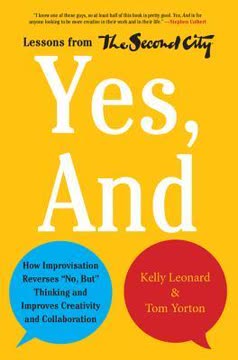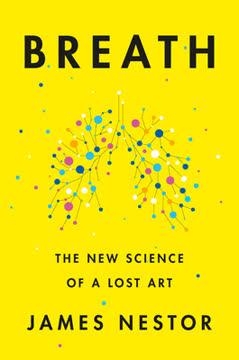Key Takeaways
1. Improvisation is about fearless creation, not following rules
At the top of an improv scene, in the first crucial moments, it is far more important that you do something than what it is you actually do.
Just do something. The key to successful improvisation is taking action without overthinking. Instead of worrying about following rules or making the "right" choice, focus on making any choice boldly and immediately. This fearless approach snaps you out of your head and into a state of play, which is essential for good improvisation.
Rules can hinder creativity. While many improv classes teach a set of rules (e.g., "Don't deny," "Don't ask questions"), these can actually be counterproductive. They often lead to overthinking and self-censorship, rather than spontaneous creation. Instead of trying to follow rules, trust your instincts and commit fully to whatever choice you make in the moment.
Embrace the unknown. Good improvisation comes from a place of discovery, not pre-planning. By making strong choices without knowing where they'll lead, you open yourself up to surprising and delightful possibilities. This approach creates more authentic and engaging scenes than trying to force a predetermined outcome.
2. Take care of yourself first, then support your partner
You want to support your partner? Do something now.
Establish your own character. The best way to support your scene partner is to first establish a strong character or point of view for yourself. This gives your partner something concrete to react to and play off of. By taking care of your own "deal" in the scene, you provide a solid foundation for both of you to build upon.
Power, not fear. Many improvisers mistakenly think that "supporting your partner" means being passive or deferential. In reality, the most supportive thing you can do is make bold choices and commit to them fully. This creates energy and momentum in the scene, which benefits both performers.
Listen actively. Once you've established your own character, listen carefully to your partner's choices and respond to them through the lens of your established point of view. This creates a dynamic back-and-forth that propels the scene forward naturally.
3. Establish and maintain a strong point of view
Hold on to what you acknowledged yourself doing and how you did it, and do it more, in every way possible and at every opportunity.
Commit to your choice. Once you've established a character or point of view in a scene, stick with it and amplify it. Resist the urge to abandon your initial choice if it doesn't immediately get laughs or feels uncomfortable. The magic of improvisation often comes from fully exploring and heightening a single strong choice.
Heighten and explore. Look for ways to make your character's perspective more extreme or specific as the scene progresses. This creates comedic tension and gives the audience a clear sense of what the scene is about. For example, if your character starts out mildly annoyed, they might become increasingly outraged as the scene continues.
Filter everything through your lens. Respond to all new information and your partner's choices through the perspective of your established character. This creates consistency and allows for organic discovery within the scene. It also helps prevent the common pitfall of abandoning your point of view when presented with new information.
4. Context is everything in improvisation
Context is everything in everything.
Establish the scene's reality. The context of a scene – its setting, relationships, and underlying dynamics – provides the framework for everything that happens. Quickly establishing and agreeing upon this context gives both performers and the audience a shared understanding of the scene's "rules."
Use context as a guide. Once the context is established, use it to inform all your choices within the scene. This creates coherence and allows for more nuanced and specific humor. For example, if the context is a tense job interview, every action and line of dialogue should reflect and heighten that underlying tension.
Subvert expectations within context. While maintaining the established context, look for opportunities to surprise the audience by making unexpected choices that still fit within the scene's reality. This creates moments of delight and humor without derailing the scene's coherence.
5. Surprise within the established context
Surprising from within the context usually results in laughter.
Find the unexpected. Once you've established the context of a scene, look for ways to make surprising choices that still fit within that framework. This creates moments of delight for the audience without derailing the scene's coherence. For example, in a scene about strict parents, having one suddenly break into a silly dance would be surprising yet still consistent with the established dynamic.
Use specificity. Adding specific, unusual details to your character or the scene can create surprising moments. Instead of generic responses, offer oddly particular information that catches your partner and the audience off guard. This specificity often leads to laugh-worthy moments and gives the scene more depth.
Throw curve balls. Occasionally introduce an element that seems completely unrelated to the scene, then find a way to justify and incorporate it. This technique keeps scenes fresh and unpredictable, while challenging you to make creative connections. However, use this sparingly and always work to connect it back to the scene's core.
6. Overcome common pitfalls in improvisation
Learn not to apologize before presenting your work.
Avoid justifying. Resist the urge to explain why you or your character are behaving a certain way. This often comes from a place of fear and can drain energy from the scene. Instead, fully commit to your choices without feeling the need to rationalize them.
Don't talk too much. Overtalking is often a sign of nervousness or trying to find something that works. Practice saying one short, impactful sentence at a time and then allowing space for your partner to respond. This creates a more natural rhythm and prevents you from getting stuck in your head.
Embrace silences. Many improvisers rush to fill every moment with dialogue out of fear. Learning to be comfortable with moments of silence can create powerful tension and give both performers and the audience time to process what's happening in the scene.
Maintain your point of view. Resist the temptation to abandon your established character or perspective when the scene gets difficult. Instead, double down on your initial choice and find new ways to express it. This creates consistency and often leads to more interesting discoveries within the scene.
7. Advanced techniques for richer, funnier scenes
Specificity is one of the most effective tools in improvisation and easiest to do.
Use specificity. Adding highly specific details to your character, dialogue, or the scene's environment creates a richer, more engaging world. Instead of generic statements, offer oddly particular information. This often leads to laugh-worthy moments and gives the audience more to latch onto.
Employ the "pull out/pull back in" technique. Temporarily go against your established point of view, then quickly return to it. This creates dynamic tension and can lead to humorous moments of self-realization for your character. For example, a character who hates parties might briefly get excited about one, then immediately regret their enthusiasm.
Create personal objects and mannerisms. Give your character a specific physical object they interact with or a unique mannerism. This adds depth to your portrayal and often provides opportunities for physical comedy. For instance, an executive might constantly play with a yo-yo during important conversations.
Vary your energy and choices. Be aware of the patterns in your performances and consciously work to break them. If you notice you've played several loud, angry characters in a row, challenge yourself to play a quiet, timid one next. This expands your range and keeps your improvisation fresh.
8. Auditioning and performance guidelines for improvisers
Although it looks like the auditors are indifferent to you or maybe even don't appear to want you to do well, the opposite is, in fact, true. They not only want you to do well, they are dying for you to do well.
Embrace the audition energy. Understand that auditors genuinely want you to succeed. Instead of being intimidated by the somber atmosphere, use it as motivation to bring extra energy and playfulness to your performance. Your willingness to fully commit despite the tense environment will make you stand out.
Show range and variety. In auditions and performances, demonstrate your ability to play different types of characters and emotions. Avoid falling into patterns or relying on a single "go-to" character. Consciously vary your volume, energy level, and physical choices to showcase your versatility.
- Emotional range: Shift between joy, anger, sadness, fear, etc.
- Physical variety: Explore different postures, movements, and levels (standing, sitting, lying down)
- Vocal diversity: Play with accents, pitch, volume, and speaking rhythms
Be professional and prepared. Treat improvisation as a serious craft, not just casual fun. Take acting classes to improve your skills, arrive at auditions and performances well-rested and focused, and present yourself professionally. This demonstrates your commitment and sets you apart from those who approach improv too casually.
9. The thermodynamics of improv: Energy and entropy
Whatever the scene is about, once you lose the energy of it, you can never get it back.
Understand scene energy. Think of an improv scene as a closed system with a finite amount of energy. Every choice, line of dialogue, and action either contributes to or detracts from the scene's overall energy. Your goal is to maximize the energy directed towards what the scene is truly about.
Minimize wasted energy. Recognize that any choice that doesn't serve the core of the scene (its "engine") is wasted energy that can never be recaptured. This includes breaking character, going off on tangents, or making choices that contradict the established reality. Focus on making every word and action count.
Combat entropy. Just as physical systems tend towards disorder over time, improv scenes naturally lose energy if not actively maintained. Constantly look for ways to heighten and explore the core idea of the scene. This might involve:
- Raising the stakes
- Deepening character relationships
- Exploring new facets of the established premise
- Finding surprising ways to reaffirm the scene's central conflict or dynamic
By understanding this energy principle, you can create more focused, engaging, and sustainable improv scenes.
Last updated:
FAQ
What's "Improvise. Scene from the Inside Out" by Mick Napier about?
- Focus on Improvisation: The book delves into the art of improvisation, emphasizing the spontaneity and creativity involved in making up scenes on the spot.
- Practical Guidance: It offers practical advice and techniques for improvisers to enhance their skills, focusing on scene work and character development.
- Personal Journey: Mick Napier shares his personal journey from aspiring veterinarian to passionate improviser, providing insights into his experiences and the evolution of his improvisational philosophy.
- Breaking Traditional Rules: The book challenges traditional improv rules, encouraging improvisers to find their own path and make bold choices.
Why should I read "Improvise. Scene from the Inside Out"?
- Unique Perspective: Mick Napier provides a fresh perspective on improvisation, challenging conventional rules and encouraging a more personal approach.
- Practical Tips: The book is filled with practical tips and exercises that can be applied immediately to improve improvisational skills.
- Inspiration for Improvisers: It serves as an inspiration for both beginners and seasoned improvisers, offering new ways to think about and approach improv.
- Comprehensive Coverage: From basic concepts to advanced techniques, the book covers a wide range of topics relevant to anyone interested in improv.
What are the key takeaways of "Improvise. Scene from the Inside Out"?
- Do Something: At the start of a scene, it's more important to do something than to worry about what to do. This helps snap you out of your head and into the moment.
- Break the Rules: Traditional improv rules can be limiting. Napier encourages improvisers to break these rules and find their own way to create engaging scenes.
- Context is Key: Understanding and maintaining the context of a scene is crucial. It provides a roadmap for the improvisers and helps the audience follow along.
- Support Through Strength: The best way to support your partner is by making strong choices yourself, which in turn supports the scene as a whole.
What is Mick Napier's approach to breaking traditional improv rules?
- Questioning the Rules: Napier questions the effectiveness of traditional improv rules, suggesting they can hinder creativity and spontaneity.
- Focus on Play: He emphasizes the importance of play and discovery over adhering to a set of predefined rules.
- Encouraging Bold Choices: Napier encourages improvisers to make bold, fearless choices that may not align with conventional rules but enhance the scene.
- Personal Experience: His approach is informed by his own experiences and observations in the world of improv, where he found that breaking rules often led to more engaging performances.
How does Mick Napier suggest improvisers handle fear in scenes?
- Acknowledge Fear: Recognize that fear is a natural part of improvisation and can lead to protective behaviors that hinder performance.
- Embrace Playfulness: Shift focus from fear to playfulness, allowing for more spontaneous and creative choices.
- Stay Out of Your Head: Avoid overthinking by making immediate choices and committing to them, which helps reduce fear-driven hesitation.
- Use Fear as Fuel: Transform fear into a driving force for bold and unexpected choices that can enhance the scene.
What exercises does "Improvise. Scene from the Inside Out" recommend for improvisers?
- Dada Monologue: Engage in nonsensical monologues to free up random associations and stimulate creativity.
- Word Association: Practice quick associations with random words to enhance spontaneity and storytelling skills.
- Gibberish Scenes: Use gibberish to focus on emotional expression and character development without relying on words.
- Solo Character Switches: Rapidly switch between different characters to build versatility and quick thinking.
What is the significance of context in improvisation according to Mick Napier?
- Defines the Scene: Context provides a framework for the scene, helping improvisers and the audience understand what is happening.
- Guides Choices: It serves as a guide for making choices that are consistent with the established reality of the scene.
- Enhances Engagement: A well-defined context keeps the audience engaged by providing a clear and coherent narrative.
- Allows for Surprises: Within a strong context, improvisers can introduce surprising elements that enhance the scene without confusing the audience.
How does Mick Napier address the concept of supporting your partner in improv?
- Self-Support First: Napier emphasizes taking care of yourself first by making strong choices, which inherently supports your partner.
- Power Over Fear: Support your partner by bringing power and confidence to the scene, rather than fear and hesitation.
- Mutual Creation: Both partners contribute to the scene's development through their individual choices, creating a shared reality.
- Listening and Responding: Effective support involves actively listening and responding through your character's perspective, rather than simply agreeing.
What advanced improvisation techniques are discussed in "Improvise. Scene from the Inside Out"?
- Opposite Choices: Make unexpected choices that defy typical associations, adding depth and surprise to scenes.
- Specificity: Use detailed and specific language to enrich scenes and provide clearer context for the audience.
- Curve Balls: Introduce seemingly unrelated elements into a scene and find ways to integrate them, adding complexity and interest.
- Heightening: Continuously build on your character's point of view to maintain energy and drive the scene forward.
What are some common problems in improv scenes and how does Mick Napier suggest addressing them?
- Too Much Exposition: Avoid overloading scenes with information; focus on strong initiations and let details emerge naturally.
- Talking Too Much: Be mindful of over-talking; practice concise communication and allow space for your partner to contribute.
- Justifying Actions: Resist the urge to justify actions or behaviors; trust the scene and let it unfold without over-explanation.
- Pausing and Hesitation: Combat pauses by committing to immediate responses, keeping the scene dynamic and engaging.
What are the best quotes from "Improvise. Scene from the Inside Out" and what do they mean?
- "Do something, anything." This quote emphasizes the importance of action over inaction at the start of a scene, encouraging improvisers to break free from hesitation.
- "Support your partner with your power, not your fear." Napier highlights the value of bringing strength and confidence to a scene, which inherently supports your partner.
- "Improvisation, always different, always the same." This reflects the paradox of improv, where each scene is unique yet often follows familiar patterns, urging improvisers to break the mold.
- "The magic of improvisation doesn't happen because you did or did not follow rules." This quote challenges the reliance on traditional rules, suggesting that true creativity comes from personal expression and bold choices.
How does Mick Napier's personal journey influence his approach to improvisation?
- Unexpected Path: Napier's transition from aspiring veterinarian to improviser highlights the unpredictable nature of creative pursuits.
- Passion for Improv: His discovery of improvisation as a way to perform without rehearsals fueled his passion and shaped his approach.
- Forming a Point of View: His experiences in Chicago's improv scene helped him develop a unique perspective on what makes improvisation work.
- Valuing Rehearsal: Despite his initial desire to avoid rehearsals, Napier now appreciates their value, balancing spontaneity with preparation in his teachings.
Review Summary
Readers praise Napier's direct, no-nonsense approach to improv, appreciating his emphasis on bold choices and self-confidence. Many find the book's exercises and practical advice invaluable for improving their performances. Some critics note the book's occasional controversial statements, particularly regarding gender. Overall, improvisers of various experience levels find the book thought-provoking and useful, often recommending it as essential reading for those serious about the craft.
Similar Books
Download PDF
Download EPUB
.epub digital book format is ideal for reading ebooks on phones, tablets, and e-readers.









